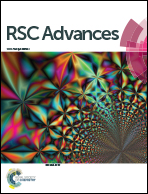Concentration-dependent spectroscopic properties and temperature sensing of YNbO4:Er3+ phosphors
Abstract
A series of YNbO4:Er3+ phosphors with various Er3+ concentrations was synthesized via a traditional high temperature, solid-state reaction method. XRD Rietveld refinements based on the XRD data were carried out to study the phase purity and crystal structure of the as-prepared samples. The results revealed that single monoclinic phase YNbO4 phosphors were obtained. The influence of the Er3+ concentration on the spectroscopic properties and temperature sensing in YNbO4:Er3+ phosphors were systematically studied. Different quenching concentrations were found in down-conversion and up-conversion luminescence processes. From lasers working current dependent up-conversion luminescence spectra, it was confirmed that two and three photon processes were responsible for both the green and the red up-conversion emissions, respectively, excited by 980 and 1550 nm lasers, which have no apparent dependence on Er3+ ion concentration. However, the Er3+ concentration had significant influences on the temperature sensing sensitivity of Er3+ ions, and the results showed that YNbO4 phosphors doped with low concentrations of Er3+ ions had high temperature sensing sensitivity and could be applied in temperature detection applications, particularly in high temperature environments.



 Please wait while we load your content...
Please wait while we load your content...